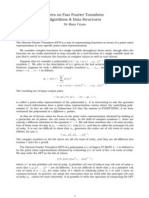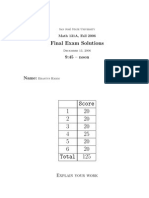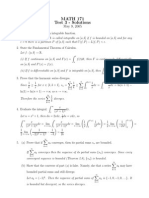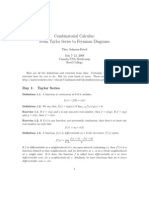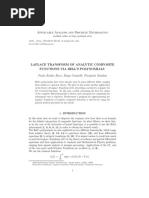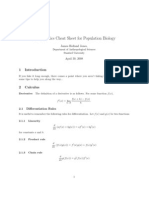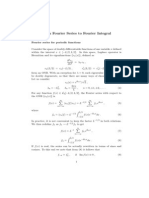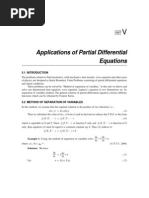18.312 Algebraic Combinatorics: Mit Opencourseware
18.312 Algebraic Combinatorics: Mit Opencourseware
Uploaded by
bmandarCopyright:
Available Formats
18.312 Algebraic Combinatorics: Mit Opencourseware
18.312 Algebraic Combinatorics: Mit Opencourseware
Uploaded by
bmandarOriginal Title
Copyright
Available Formats
Share this document
Did you find this document useful?
Is this content inappropriate?
Copyright:
Available Formats
18.312 Algebraic Combinatorics: Mit Opencourseware
18.312 Algebraic Combinatorics: Mit Opencourseware
Uploaded by
bmandarCopyright:
Available Formats
MIT OpenCourseWare http://ocw.mit.
edu
18.312 Algebraic Combinatorics
Spring 2009
For information about citing these materials or our Terms of Use, visit: http://ocw.mit.edu/terms.
Course 18.312: Algebraic Combinatorics
Lecture Notes # 1 Addendum by Gregg Musiker February 4th - 6th, 2009
Recurrence Relations and Generating Functions
Given an innite sequence of numbers, a generating function is a compact way of expressing this data. We begin with the notion of ordinary generating functions. To illustrate this denition, we start with the example of the Fibonacci numbers. {Fn } = {F0 , F1 , F2 , F3 , . . .} n=0 dened by F0 = 1, F1 = 1, and Fn = Fn1 + Fn2 for n 2. 1, 1, 2, 3, 5, 8, 13, 21, 34, . . . We dene F (X) := F0 + F1 x + F2 x2 + F3 x3 + F4 x4 + . . . = 1 + x + 2x2 + 3x3 + 5x4 + 8x5 + . . . . In other words, F (X) is the formal power series
k =0
Fk xk .
Remark. This is called a formal power series because we will consider x to be an indeterminate variable rather than a specic real number. In general, given a sequence of numbers {ai } = {a0 , a1 , a2 , a3 , . . .}, the associ i=0 ated formal power series is A(X) :=
k=0
ak xk = a0 + a1 x + a2 x2 + a3 x3 + . . . .
We will shortly write down F (X) in a compact form, but we begin with an easier example that you have already seen. 1
Recall that
n
k
n! . k!(nk)!
For example, = {1, 8, 28, 56, 70, 56, 28, 8, 1}.
88 k In fact if k > 8, sequence as 8
k
k=0
(e.g.
8 ) equals zero. Thus we can consider the entire innite 9 = {1, 8, 28, 56, 70, 56, 28, 8, 1, 0, 0, 0, . . .},
8 k
k=0
and then the associated formal power series 1 + 8x + 28x2 + 56x3 + 70x4 + 56x5 + 28x6 + 8x7 + x8 + 0x9 + 0x10 + . . . can be written compactly as (1 + x)8 . Generalizing this to any positive integer n, k has associated power series k=0 n n k n n (1 + x) , since (1 + x) = k=0 k x by the Binomial Theorem. This illustrates that from a formal power series, we can recover a sequence of numbers. We call these numbers the coecients of the formal power series. For example, we say that n is the coecient of xk in (1 + x)n . This is sometimes k n written as (1 + x) = n or [xk ](1 + x)n = n . k k
xk
1.1
More complicated formal power series
k We now want to write a similar expression for F (X) = k=0 Fk x , where Fk = Fk1 + Fk2 for k 2 and F0 = F1 = 1. Notice that k k ak x bk x = (ak bk )xk .
k=0 k=0 k=0
As a consequence, Fk = Fk1 + Fk2 for k 2 implies F (X) = 1 + F1 x + = 1 + F1 x + = 1 + F1 x +
Fk xk
(Fk1 + Fk2 )xk Fk1 x +
k k=2
k=2
k=2 k=2
Fk2 xk
= 1 + F1 x + xF (X) F0 x + x2 F (X).
Thus F (X)(1 x x2 ) = 1 + (F1 F0 )x = 1 + 0x and we obtain the rational expression F (X) = 1 . 1 x x2
If we look at the Taylor series for this rational function, we indeed obtain coef cients that are the Fibonacci numbers. Generating Functions are also helpful for obtaining closed formulas or asymptotic formulas. If we use partial fraction decomposition, we see that F (X) = B A + . 1 1 x 1 2 x
We know that (1 1 x)(1 2 x) = 1 x x2 so 1 2 = 1 1 2 = 1 Thus {1 , 2 } = { 1+2 5 , 12 5 }. Exercise 1: Solve for A and B and use this to obtain a closed form expression for Fk . Notice that as a consequence we can compute that {Fk+1 /Fk } = {1/1, 2/1, 3/2, 5/3, 8/5, 13/8, . . .} k converges to 1+2 5 since 12 5 0 as k , so Ak+1 Ak+1 + Bk+1 1 2 1 = 1 . k k A1 + B2 Ak 1
and
1.2
A Combinatorial Interpretation of the Fibonacci Num bers
Given a sequence of integers S = {s0 , s1 , s2 , . . .}, a combinatorial interpretation of S is a family F of objects (of various sizes) such that the number of objects in F of size k is exactly counted by sk . For example, a combinatorial interpretation of n is as the number of subsets k of an {1, 2, . . . , n} of size k. A domino tiling of a rectangular region R is a covering of R by horizontal (1-by-2) domino tiles and vertical (2-by-1) domino tiles such that every square of R is covered by exactly one domino.
For example, if we let R be a 2-by-2 grid, then there are two possible domino tilings. Either both tiles are vertical or both are horizontal. If we let R be a 2-by-3 grid, then there are three possible domino tilings, and a 2-by-4 grid would have ve such domino tilings. Proposition. The number of domino tilings of a 2-by-n grid is counted by the nth Fibonacci number, Fn for n 1. Proof. Let DTn denote the number of domino tilings of the 2-by-n grid. We rst check the initial conditions. There is one way to tile the 2-by-1 grid, and there are two ways to tile the 2-by-2 grid. Thus DT1 = 1 = F1 and DT2 = 2 = F2 . (Recall that F0 = 1, but we do not use this quantity in this combinatorial interpretation.) Domino tilings of the 2-by-n grid either look like a domino tiling of the 2-by (n 1) grid with a vertical tile tacked onto the end, or a domino tiling of the 2-by-(n 2) grid with two horizontal tiles tacked onto the end. Consequently, DTn = DTn1 + DTn2 , the same recurrence as the Fn s. Exercise 2: Show that this combinatorial interpretation can be rephrased as the statement Fn = The number of subsets S of {a1 , a2 , . . . , an1 } such that ai and ai+1 are not both contained in S.
1.3
Convolution Product Formula
In addition to adding formal power series together, we can also multiply them. If A(X) = ak xk and B(X) = bk xk , where ak (resp. bk ) counts the number k =0 k =0 of objects of type A (resp. B) and size k, then A(X)B(X) = C(X) =
n=0
cn xn
where cn = n ak bnk , and has a combinatorial interpretation as the number of k=0 objects of size n formed by taking an object of type A and concatenating it with an object of type B.
1.4
Connection between Linear Recurrences and Rational Generating Functions
The behavior we saw of the Fibonacci numbers and its generating function is an example of a more general theorem. Theorem. (Theorem 4.1.1 of Enumerative Combinatorics 1 by Richard Stanley) Let 1 , 2 , . . . , d be a xed sequence of complex numbers, d 1, and d = 0. The following conditions on a function f : N C are equivalent: i) The generating function F (X) equals
n=0
f (n)xn =
P (x) Q(x)
where Q(x) = 1 + 1 x + 2 x2 + . . . + d xd and P (x) is a polynomial of degree < d. ii) For all n 0, f (n) satises the linear recurrence relation f (n + d) + 1 f (n + d 1) + 2 f (n + d 2) + . . . + d f (n) = 0. iii) For all n 0, f (n) = where 1 + 1 x + 2 x + . . . + d x =
2 d k i=1
Pi (n)in
k i=1
(1 i x)ei
with the is distinct and each Pi (n) is a univariate polynomial (in n) of degree less than ei . Dention. A generating function of the form erating function.
P (x) Q(x)
is a called a rational gen-
You might also like
- SolutionsDocument71 pagesSolutionsJoshua Mendez100% (2)
- JSSStandards - JSS 55555 - 2000Document358 pagesJSSStandards - JSS 55555 - 2000Rusha Rao89% (19)
- Final SolDocument21 pagesFinal SolChuan HeNo ratings yet
- Session 24: Recursion and Recurrence RelationsDocument19 pagesSession 24: Recursion and Recurrence RelationsNalam AshikaNo ratings yet
- Functional Analysis PDFDocument286 pagesFunctional Analysis PDFbmandar100% (1)
- Solved Book ProblemsDocument11 pagesSolved Book ProblemsLeslie Zavaleta BazanNo ratings yet
- Bernoulli Numbers and The Euler-Maclaurin Summation FormulaDocument10 pagesBernoulli Numbers and The Euler-Maclaurin Summation FormulaApel_Apel_KingNo ratings yet
- 18 GenfuncDocument20 pages18 GenfuncDương Minh ĐứcNo ratings yet
- Final CribDocument10 pagesFinal CribAmber LucasNo ratings yet
- Notes On Fast Fourier Transform Algorithms & Data StructuresDocument11 pagesNotes On Fast Fourier Transform Algorithms & Data Structures"The Dangerous One"No ratings yet
- A Determinant Involving Generalized Binomial CoefficientsDocument112 pagesA Determinant Involving Generalized Binomial Coefficientsksr131No ratings yet
- Strategies 1 Number Theory 1Document10 pagesStrategies 1 Number Theory 1Rituraj TripathyNo ratings yet
- Chapter 1Document68 pagesChapter 1chinasingh123No ratings yet
- Fourier Series, Discrete Fourier Transforms and Fast Fourier TransformsDocument6 pagesFourier Series, Discrete Fourier Transforms and Fast Fourier Transformsbnm007No ratings yet
- Finite Fourier Series: C Can Be Identified VDocument7 pagesFinite Fourier Series: C Can Be Identified VKamalakannan ShanmugamNo ratings yet
- Functions, Graphs, and Limits: By: Husni Tel: 0615257175 Alas Tel: 0615521558Document56 pagesFunctions, Graphs, and Limits: By: Husni Tel: 0615257175 Alas Tel: 0615521558Abdalla ShowNo ratings yet
- SR 3 ExercisesDocument138 pagesSR 3 ExercisesissamNo ratings yet
- Sequence ProbDocument7 pagesSequence ProbDebabrata NagNo ratings yet
- Report On RecursionDocument12 pagesReport On RecursiongouriNo ratings yet
- Solutions To Exercises 7.1: X Has Period TDocument16 pagesSolutions To Exercises 7.1: X Has Period TTri Phương NguyễnNo ratings yet
- Full-Range Fourier SeriesDocument8 pagesFull-Range Fourier SeriesandraaaaapmNo ratings yet
- 316s Answer10 PDFDocument3 pages316s Answer10 PDFjisteeleNo ratings yet
- IEOR 6711: Stochastic Models I Fall 2012, Professor Whitt Solutions To Homework Assignment 1Document16 pagesIEOR 6711: Stochastic Models I Fall 2012, Professor Whitt Solutions To Homework Assignment 1Songya PanNo ratings yet
- Prékopa - 1973 - On Logarithmic Concave Measures and FunctionsDocument9 pagesPrékopa - 1973 - On Logarithmic Concave Measures and FunctionsindifferentjNo ratings yet
- Function Equation BasicDocument9 pagesFunction Equation Basicmonkeydbomlol123No ratings yet
- MATH 171 Test 3 - SolutionsDocument1 pageMATH 171 Test 3 - SolutionslusienopopNo ratings yet
- Algebra1section5 2Document6 pagesAlgebra1section5 2api-358505269No ratings yet
- Combinatorial Calculus ExefrcisesDocument12 pagesCombinatorial Calculus ExefrcisesAnca O. ArionNo ratings yet
- LT Aadm LastDocument15 pagesLT Aadm LastVladimir BecejacNo ratings yet
- Preparation For Calculus and Functions: Pamantasan NG CabuyaoDocument7 pagesPreparation For Calculus and Functions: Pamantasan NG CabuyaoJhon Mark SantoniaNo ratings yet
- NCSC 201 Discrete Mathematics NotesDocument39 pagesNCSC 201 Discrete Mathematics NotesTawanda NaiteNo ratings yet
- Midterm One 6711 F10 SolsDocument8 pagesMidterm One 6711 F10 SolsSongya PanNo ratings yet
- PS 1 2007Document5 pagesPS 1 2007am1liNo ratings yet
- Poisson's Equation by The FEM Using A MATLAB Mesh Generator: 4u F U 0 On DDocument6 pagesPoisson's Equation by The FEM Using A MATLAB Mesh Generator: 4u F U 0 On DRuben Dario Guerrero ENo ratings yet
- Midterm Solutions 2013Document12 pagesMidterm Solutions 2013Nonitus OctingentiNo ratings yet
- Fas F (N) F (D) .: Pete L. ClarkDocument6 pagesFas F (N) F (D) .: Pete L. Clarksticker592No ratings yet
- IRC - 1 MathematicsDocument8 pagesIRC - 1 MathematicsNIRAJ KUMARNo ratings yet
- Mathematics Cheat Sheet For Population Biology: James Holland JonesDocument9 pagesMathematics Cheat Sheet For Population Biology: James Holland JonesDinesh BarupalNo ratings yet
- Functions 1 (MATH 1207)Document15 pagesFunctions 1 (MATH 1207)billmusa42No ratings yet
- A Simple Yet Efficient Two Step Fifth Order Weighted Newton Method For Nonlinear ModelsDocument23 pagesA Simple Yet Efficient Two Step Fifth Order Weighted Newton Method For Nonlinear ModelsAntmel Rodriguez CabralNo ratings yet
- Pset 01Document9 pagesPset 01Yeon Jin Grace LeeNo ratings yet
- Functional Equations: 1. Basic Techniques in Solving Functional Equations in One VariableDocument9 pagesFunctional Equations: 1. Basic Techniques in Solving Functional Equations in One VariableEduardoNo ratings yet
- Generalized Fibonacci SequencesDocument14 pagesGeneralized Fibonacci SequencesEmochu Alupo EmmaNo ratings yet
- Least SquareDocument3 pagesLeast SquareSagar Ahir100% (1)
- Laurent Bartholdi: 0 N 1 0 1 J J J J 1 J J J 1 J JDocument7 pagesLaurent Bartholdi: 0 N 1 0 1 J J J J 1 J J J 1 J JБорис КадецNo ratings yet
- Variations On A Theme of Boole and Stein-WeissDocument5 pagesVariations On A Theme of Boole and Stein-WeisslumonzonNo ratings yet
- Theorist's Toolkit Lecture 10: Discrete Fourier Transform and Its UsesDocument9 pagesTheorist's Toolkit Lecture 10: Discrete Fourier Transform and Its UsesJeremyKunNo ratings yet
- Maths IntgrationDocument153 pagesMaths IntgrationLI DiaNo ratings yet
- 1.1 Mathematical Model of Production: Tornike KadeishviliDocument13 pages1.1 Mathematical Model of Production: Tornike Kadeishviligiorgiguli21No ratings yet
- From Fourier Series To Fourier Integral: e X E, e eDocument10 pagesFrom Fourier Series To Fourier Integral: e X E, e evarun186No ratings yet
- Teoria Dei Numeri SpaventoDocument39 pagesTeoria Dei Numeri SpaventoAndrea GenitoniNo ratings yet
- Weird CalculusDocument39 pagesWeird CalculusIan BeardsleyNo ratings yet
- 2 12 PDFDocument10 pages2 12 PDFRachel WatsonNo ratings yet
- 10 Rep AliceFeldmannDocument11 pages10 Rep AliceFeldmannFariz Samkriets LuktaNo ratings yet
- Abstract Algebra SolutionsDocument141 pagesAbstract Algebra SolutionsThigpen Fockspace88% (8)
- Convolution and Equidistribution: Sato-Tate Theorems for Finite-Field Mellin TransformsFrom EverandConvolution and Equidistribution: Sato-Tate Theorems for Finite-Field Mellin TransformsNo ratings yet
- Functional Operators, Volume 2: The Geometry of Orthogonal SpacesFrom EverandFunctional Operators, Volume 2: The Geometry of Orthogonal SpacesNo ratings yet
- Beginning Functional Analysis PDFDocument211 pagesBeginning Functional Analysis PDFbmandar100% (5)
- Problems On Group TheoryDocument25 pagesProblems On Group TheorybmandarNo ratings yet
- Differentialgeom 003681 MBPDocument281 pagesDifferentialgeom 003681 MBPNavin_Fogla_7509100% (1)
- Differential Geometry Lectures WrossmannDocument221 pagesDifferential Geometry Lectures WrossmannmrossmanNo ratings yet
- Samplechapter CombinatoricsDocument34 pagesSamplechapter CombinatoricsbmandarNo ratings yet
- Intro Math MethodsDocument10 pagesIntro Math MethodsbmandarNo ratings yet
- Chapter 10Document9 pagesChapter 10bmandarNo ratings yet
- High Speed ComputationsDocument16 pagesHigh Speed ComputationsbmandarNo ratings yet
- App PDEDocument83 pagesApp PDEbmandarNo ratings yet
- Samplechapter CountingprinciplesDocument151 pagesSamplechapter CountingprinciplesbmandarNo ratings yet
- Complex AnalysisDocument53 pagesComplex AnalysisGeorgiana ZavoiNo ratings yet
- CIE09 Circular MeasureDocument10 pagesCIE09 Circular MeasurelijasperawesomeNo ratings yet
- Expt 4 - PHY430 - Simple Pendulum - 6.8.10Document5 pagesExpt 4 - PHY430 - Simple Pendulum - 6.8.10Mary Ann Angeles PangilinanNo ratings yet
- Production Scheduling PDFDocument21 pagesProduction Scheduling PDFRaajithaNo ratings yet
- Calculus - Better Explained A Guide To Developing Lasting IntuitionDocument76 pagesCalculus - Better Explained A Guide To Developing Lasting IntuitionAnibal Gomes100% (1)
- Emt SyllabusDocument3 pagesEmt SyllabusJasvinder kourNo ratings yet
- Aur BasicsDocument49 pagesAur BasicsAswathy AswathyNo ratings yet
- Codingg Scheme For Visual FoxproDocument3 pagesCodingg Scheme For Visual FoxproJessica MartinezNo ratings yet
- Vision - PotentialDocument4 pagesVision - PotentialRamesh KumarNo ratings yet
- Data SheetsDocument2 pagesData SheetsRaashmiNo ratings yet
- Diploma Programmes Main Examination: Dipl/Qts0109/May2018/MaineqpDocument17 pagesDiploma Programmes Main Examination: Dipl/Qts0109/May2018/MaineqpMay JingNo ratings yet
- Year 5 Mathematics-WorkbookDocument55 pagesYear 5 Mathematics-Workbookjothi balajiNo ratings yet
- The Double Pendulum of Variable MassDocument6 pagesThe Double Pendulum of Variable MassRh EspindolaNo ratings yet
- Ashikhmin ShirleyDocument7 pagesAshikhmin Shirleyrobert.arriaga36No ratings yet
- Geomechanics and RockmechanicsDocument7 pagesGeomechanics and RockmechanicsGabriel OmondiNo ratings yet
- Math 8 AssignmentDocument3 pagesMath 8 AssignmentCool PinguNo ratings yet
- Tic Tac Toe Nabeegh Ahmed (19L-1098), Muhammad Hassan (19L-1011) Section 2BDocument10 pagesTic Tac Toe Nabeegh Ahmed (19L-1098), Muhammad Hassan (19L-1011) Section 2BMuhammad Ali Haider100% (1)
- 4MA0 4HR Que 20180608Document24 pages4MA0 4HR Que 20180608Newton JohnNo ratings yet
- Geometric Design of Highways and RailwaysDocument17 pagesGeometric Design of Highways and Railwaysnicole.galvezNo ratings yet
- Unsupervised Machine LearningDocument10 pagesUnsupervised Machine LearningAnanya SNo ratings yet
- Stove, David - Popper and After NotesDocument4 pagesStove, David - Popper and After NotesYork LuethjeNo ratings yet
- Parametric IITGDocument14 pagesParametric IITGBattle SagaNo ratings yet
- IRENE SANONG Maam abordoLPDocument6 pagesIRENE SANONG Maam abordoLPpauljohn sacasacNo ratings yet
- Control Systems Notes DEE M2 JuneDocument34 pagesControl Systems Notes DEE M2 JuneThairu MuiruriNo ratings yet
- CHP 07 AnsDocument28 pagesCHP 07 AnsMukundkriNo ratings yet
- Introduction To Genetic AlgorithmDocument26 pagesIntroduction To Genetic AlgorithmDESTELLO GAMINGNo ratings yet
- IMPA, Instituto de Matematica Pura e Aplicada: Research CentresDocument4 pagesIMPA, Instituto de Matematica Pura e Aplicada: Research CentresThayzon Yldefonso Arias ⃝⃤No ratings yet
- Sentek - How To Select A Vibration Testing System - Kvalitest IndustrialDocument16 pagesSentek - How To Select A Vibration Testing System - Kvalitest IndustrialPekkaNo ratings yet
- Special Lab Report 2 Simple PendulumDocument15 pagesSpecial Lab Report 2 Simple Pendulumapi-656454154No ratings yet









